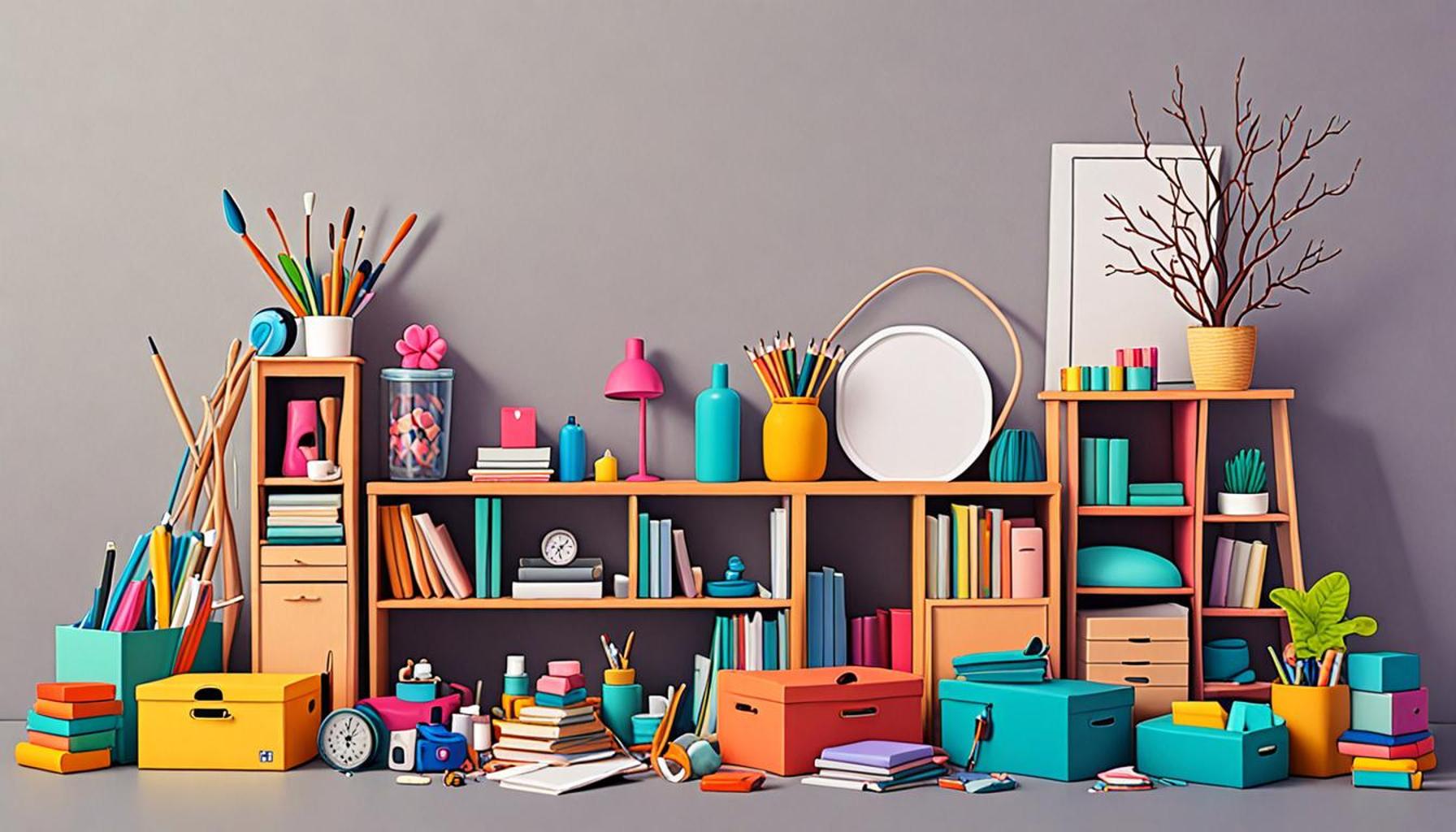Demystifying Decluttering: How to Overcome Procrastination and Start Organizing

The Hidden Costs of Clutter
In today’s fast-paced world, many Americans find themselves held back by the strong grip of procrastination when it comes to organizing their living spaces. This delay can transform the simple act of decluttering into an overwhelming endeavor, where feelings of frustration and inadequacy often take the lead. However, understanding the implications of living amidst clutter can provide the necessary motivation to take action.
The adverse effects of a disorganized environment are supported by a wealth of research indicating its influence on both mental health and productivity. Consider the following aspects:
- Increased stress: A chaotic space can significantly heighten levels of anxiety. Studies show that people living in cluttered environments often report feeling more stressed, which can lead to difficulty relaxing or unwinding after a long day.
- Decision fatigue: When a home is filled with too many possessions, even mundane choices like what to wear or what to cook can become overwhelming. This effect, known as decision fatigue, can lead to procrastination on even the simplest tasks.
- Reduced focus: Clutter can be a significant distraction, preventing individuals from concentrating on their work or important activities. Research suggests that environments filled with unnecessary items can lower overall efficiency and creativity.
Understanding the psychological barriers to decluttering is essential for anyone looking to make a change. Procrastination often arises from fear—fear of failure or even fear of making the wrong decision about what to keep or toss. Additionally, the enormity of the task can be paralyzing, as many individuals are unsure where to begin.
However, the journey toward an organized home does not have to be a Herculean struggle; it can be an enjoyable and fulfilling process when approached with the right mindset. In the following sections, we will delve into:
- Strategies to overcome procrastination, including methods like the Pomodoro Technique and setting small, achievable goals.
- Practical steps to begin organizing, such as the popular “four-box method,” which categorizes items into keep, donate, trash, or relocate.
- The psychological benefits of a clutter-free environment, showcasing how tidiness can lead to enhanced well-being and sharper focus.
Get ready to uncover effective methods and insightful tips that have the potential to help you conquer clutter once and for all! As you embark on this journey, keep in mind that small changes can lead to monumental transformations in your lifestyle and mindset.

DISCOVER MORE: Click here to streamline your online life
Breaking Down the Barriers: Understanding Procrastination in Decluttering
Before diving into the practicalities of decluttering, it’s essential to address the psychological barriers that often lead to procrastination. Understanding these hurdles can empower individuals to take the initiative and transform their living spaces. One primary factor behind procrastination is the overwhelming nature of the task at hand. When faced with an entire room (or even the entire house) that requires organizing, the sheer scale can lead to feelings of helplessness. Many people simply do not know where to start, resulting in a tendency to avoid the task altogether.
Another significant barrier is the attachment to possessions. Items often carry sentimental value, and deciding whether to keep or discard them can trigger emotional responses. This emotional attachment can create conflict and lead to decision paralysis, where even the thought of sorting through belongings feels daunting. Additionally, some individuals fear making the wrong choice; the possibility of regret can become a mental roadblock that halts progress.
To help combat these feelings, it’s crucial to adopt a more manageable approach to decluttering. Here are several strategies that can minimize procrastination and motivate you to start organizing:
- Set a timer: Utilize the Pomodoro Technique, which involves working for a specific amount of time—like 25 minutes—followed by a short break. This method can make decluttering feel less laborious and more manageable.
- Break it down: Instead of tackling the whole house, choose one section or category of items, such as clothes or kitchen utensils, to focus on during one session. Small victories can build momentum.
- Visualize the outcome: Imagine how your space will look and feel once it’s organized. This visualization can provide the motivation needed to start; picturing a serene environment can inspire action.
- Incorporate a buddy system: Enlist a friend or family member to declutter with you. Not only can they offer emotional support, but they can help hold you accountable and make the process more enjoyable.
By tackling procrastination with these strategies, you can find clarity and purpose, paving the way toward a more organized living space. Remember, the journey of decluttering is as much about mindset as it is about physical organization.
In the next section, we will delve deeper into practical decluttering methods that not only simplify the process but also make it rewarding. Understanding how to categorize and evaluate your belongings will be essential in building a cleaner and more intentional living environment.
Understanding the Psychology Behind Procrastination
Procrastination often stems from a deeper psychological struggle, where the act of decluttering may feel overwhelming or daunting. Many individuals associate clutter with personal failure or embarrassment, which creates a mental block that prevents them from taking action. Recognizing this pattern is crucial in overcoming procrastination. One effective technique to combat this is the five-minute rule. By committing to decluttering for just five minutes, you can significantly lower the psychological barrier to getting started. Once you initiate the process, momentum often carries you forward. Additionally, breaking the task into small, manageable segments can provide immediate satisfaction, further encouraging continued effort.
Creating a Decluttering Ecosystem
To foster the motivation to declutter, creating a supportive environment is essential. Surround yourself with organization tools such as boxes, labels, and lists. Utilizing these tools can make the decluttering process feel more systematic and less chaotic. A visual reminder of your goals, such as a vision board focusing on a calm, organized space, can also keep you inspired to maintain the effort.Another impactful strategy is to involve others in the process. Share your decluttering goals with friends or family, and hold each other accountable. Having an accountability partner can not only make the task more enjoyable but also provide encouragement when you face moments of doubt or procrastination.These tactics are designed to transform your perspective on decluttering, making the process less about loss and more about creating a lighter, more organized life. Overcoming procrastination is a gradual journey that can significantly improve not just your physical space but also your mental clarity and overall well-being.
Choosing the Right Method
When starting your decluttering journey, choose a method that resonates with you. The Marie Kondo method, for instance, encourages individuals to examine their belongings and keep only those that “spark joy.” This can be a liberating approach to decide what items deserve a place in your life. On the other hand, the minimalist approach focuses on the intentional culling of possessions to create a more streamlined lifestyle.By understanding the psychology of procrastination, establishing a supportive ecosystem, and choosing a decluttering method that suits your style, you empower yourself to take control of your environment. This process not only enhances your organization skills but also fosters a sense of accomplishment and peace in your life. With the right mindset and tools, anyone can conquer the clutter and embrace a more purposeful living space.
DISCOVER MORE: Click here for essential digital decluttering tips
Effective Decluttering Techniques: Organizing Your Space with Intent
Once you’ve tackled the psychological barriers of procrastination, it’s time to immerse yourself in the practical techniques of decluttering. By understanding how to evaluate and categorize your possessions effectively, you’ll build a more organized and peaceful living environment. Here are several robust strategies to consider:
The Four-Box Method
The Four-Box Method is a straightforward technique that helps to simplify decision-making. You’ll need four boxes labeled Keep, Donate, Trash, and Storage. As you sift through your belongings, you can place each item into one of these boxes based on your judgment:
- Keep: Items that are essential or that you love.
- Donate: Quality items you no longer use but someone else might benefit from.
- Trash: Worn-out items that are no longer usable.
- Storage: Items you only use seasonally or occasionally but don’t want to get rid of entirely.
This method encourages active decision-making and minimizes the clutter that accumulates from uncertain items. Moreover, it gives a sense of closure since unwanted items are either disposed of or find a new home.
The Marie Kondo Technique
Inspired by the world-renowned organizing expert Marie Kondo, the “KonMari Method” offers a unique approach that emphasizes joy rather than just practicality. This technique encourages individuals to hold each item and ask themselves, “Does this spark joy?” If the answer is no, it’s time to let it go. This method not only promotes a clutter-free space but also fosters a deeper connection with the items you choose to keep, creating an environment that reflects your personal joy and values.
Implementing the KonMari Method may require practice in letting go of items that might seem useful yet contribute to an overwhelming space. Still, the emotional release that follows the decluttering process can be incredibly liberating.
Creating a Decluttering Schedule
A robust decluttering plan includes a concrete schedule. Take time each week to allocate a specific amount of time solely for decluttering. You might also choose to incorporate themed decluttering days, such as “Fashion Fridays” where you focus on clothes or “Tidy Tuesdays” for tackling your kitchen space. Consistency is key here; it transforms decluttering from a massive chore into an integrated part of your life. The feeling of accomplishment from these short bursts of activity will motivate you to continue.
Digital Decluttering
In this digital age, decluttering your physical space is only half the battle. Digital clutter can be equally overwhelming, with overflowing email inboxes, disorganized files, and countless forgotten applications. Set aside dedicated time to assess and eliminate unnecessary emails and files, unsubscribe from unwanted newsletters, and sort your digital photos. A clear digital space is often just as vital as a clean physical space, leading to greater productivity and focus.
By employing these effective decluttering techniques, you can streamline your home and create environments that reflect your desires and needs. Remember, the path to a clutter-free life is a journey, not a race. Embrace each step with intention and purpose, and you’ll find that organization becomes second nature.
DIVE DEEPER: Click here to discover how minimalism can transform your life
Conclusion: Embracing the Journey to a Clutter-Free Life
In the quest for an organized life, the challenge of procrastination often looms large, but it’s essential to remember that the journey towards a clutter-free space is one of personal growth and discovery. By understanding the emotional and psychological factors that lead to clutter accumulation, you can empower yourself to take actionable steps. Implementing effective techniques like the Four-Box Method and the innovative KonMari Method helps streamline this process, guiding you towards mindful decision-making regarding your belongings.
Establishing a consistent decluttering schedule not only introduces structure but also transforms organization from an overwhelming task into a manageable and even enjoyable routine. Furthermore, in a world increasingly defined by digital interactions, tackling digital clutter plays an equally vital role in enhancing productivity and focus. This dual approach leads to a holistic sense of well-being that encompasses both physical and virtual spaces.
Ultimately, the act of decluttering is not merely about creating a tidy environment; it is about cultivating a lifestyle that reflects your values and aspirations. As you move forward, stay patient with yourself. Recognize that every small step contributes to a more peaceful and organized life. So, embrace this journey with curiosity and determination, and watch how the act of decluttering evolves into a fulfilling pursuit of clarity and purpose.


